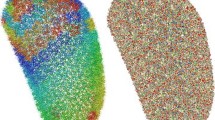Summary
We present BALLView, an extensible tool for visualizing and modeling bio-molecular structures. It provides a variety of different models for bio-molecular visualization, e.g. ball-and-stick models, molecular surfaces, or ribbon models. In contrast to most existing visualization tools, BALLView also offers rich functionality for molecular modeling and simulation, including molecular mechanics methods (AMBER and CHARMM force fields), continuum electrostatics methods employing a Finite-Difference Poisson Boltzmann solver, and secondary structure calculation. Results of these computations can be exported as publication quality images or as movies. Even unexperienced users have direct access to this functionality through an intuitive graphical user interface, which makes BALLView particularly useful for teaching. For more advanced users, BALLView is extensible in different ways. Owing to its framework design, extension on the level of C‰+‰‰+ code is very convenient. In addition, an interface to the scripting language Python allows the interactive rapid prototyping of new methods. BALLView is portable and runs on all major platforms (Windows, MacOS X, Linux, most Unix flavors). It is available free of charge under the GNU Public License (GPL) from our website http://www.ballview.org.
Similar content being viewed by others
References
1. Humphrey W., Dalke A., Schulten K. (1996) VMD - Visual Molecular Dynamics. J. Mol. Graphics, 14:33-38
DeLano W.L. The PyMOL molecular graphics system, 2002.
Discovery Studio (2005): http://www.accelrys.com/products/dstudio/index.html.
4. Sayle R., Milner-White E.J. (1995) RasMol: Biomolecular graphics for all. Trend. Biochem. Sci. (TIBS) 20(9):374
5. Guex N., Peitsch M.C. (1997) SWISS-MODEL and the Swiss-PdbViewer: An environment for comparative protein modeling. Electrophoresis 18:2714-2723
AVS visualization software (2005): http://www.avs.com.
Open MOIV: http://www.tecn.upf.es/openmoiv/.
Open Inventor: http://oss.sgi.com/projects/inventor/.
SYBYL 7.0, Tripos Inc., 1699 South Hanley Rd., St. Louis, Missouri, 63144, USA.
Molecular Operating Environment (MOE) (2005): http://www.chemcomp.com/.
11. Kohlbacher O., Lenhof H.P. (2000) BALL - Rapid Software Prototyping in Computational Molecular Biology. Bioinformatics 16(9):815–824
Python scripting language (2005): http://www.python.org.
QT library (2005): http://www.trolltech.com.
14. Nicholls A., Sharp K., Honig B. (1991) Protein folding and association: Insights from the interfacial and thermodynamic properties of hydrocarbons. PROTEINS, Struct. Func. Genet. 11(4):281ff
15. Nicholls A., Honig B. (1990) A rapid finite difference algorithm, utilizing successive over-relaxation to solve the poisson-boltzmann equation. J. Comp. Chem., 12(4):435-445
Berman, H.M., Westbrook, J., Feng, Z., Gilliland, G., Bhat, T.N., Weissig, H., Shindyalov, I.N. and Bourne, P.E. The Protein Data Bank. Nucl.Acids Res., 28, (2000) 235–242.
MOPAC (2005): http://www.cachesoftware.com/mopac/index.shtml.
POVRay renderer (2005): http://www.povray.org.
19. Boghossian N.P., Kohlbacher O., Lenhof H.P. (2000) Rapid software prototyping in molecular modeling using the biochemical algorithms library (BALL). J. Exp. Algorithmics 5:16
20. Cornell W.D., Cieplak P., Bayly C.I., Gould I.R., Merz K.M., Ferguson D.M., Spellmeyer D.C., Fox T., Caldwell J.W., Kollman P.A. (1995) A second generation force field for the simulation of proteins, nucleic acids, and organic molecules. JACS 117:5179–5197
21. Brooks B.R., Bruccoleri R.E., Olafson B.D., States D.J., Swaminathan S., Karplus M. (1983) "CHARMM: A program for macromolecular energy minimization and dynamics calculations". J. Comp. Chem. 4:187-217
22. Halgren T.A. (1996) Merck molecular force field: I. basis, form, scope, parameterization and performance of MMFF94. J. Comp. Chem., 17:490-519
23. Kabsch W., Sander C. (1983) Dictionary of protein secondary structure: Pattern recognition of hydrogen bonded and geometrical features. Biopolymers 22:2577-2637
Boghossian, N.P., Kohlbacher, O. and Lenhof, H.-P. BALL: Biochemical Algorithms Library. In Algorithm Engineering, 3rd International Workshop, WAE’99, Proceedings, volume 1668 of Lecture Notes in Computer Science (LNCS), pages 330–344. Springer, Heidelberg, 1999.
OpenGL library (2005): http://www.opengl.org.
SIP (Python bindings generator) (2005): http://www.riverbankcomputing.co.uk/sip
Acknowledgements
This work was supported in parts by Deutsche Forschungsgemeinschaft grants BIZ 1/1-3, BIZ 4/1-1 and LE 952/2-3. We want to thank the following student workers and fellow team members for their efforts: Andreas Bertsch, Andreas Kerzmann, Anne Dehof, Bettina Leonhardt, Carla Haid, Christian Bender.
Author information
Authors and Affiliations
Corresponding author
Additional information
Hans-Peter Lenhof and Oliver Kohlbacher contributed equally to this work
Rights and permissions
About this article
Cite this article
Moll, A., Hildebrandt, A., Lenhof, HP. et al. BALLView: An object-oriented molecular visualization and modeling framework. J Comput Aided Mol Des 19, 791–800 (2005). https://doi.org/10.1007/s10822-005-9027-x
Received:
Accepted:
Published:
Issue Date:
DOI: https://doi.org/10.1007/s10822-005-9027-x




